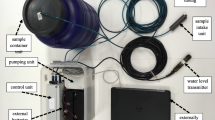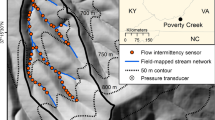Abstract
Water quality in urban streams and stormwater systems is highly dynamic, both spatially and temporally, and can change drastically during storm events. Infrequent grab samples commonly collected for estimating pollutant loadings are insufficient to characterize water quality in many urban water systems. In situ water quality measurements are being used as surrogates for continuous pollutant load estimates; however, relatively few studies have tested the validity of surrogate indicators in urban stormwater conveyances. In this paper, we describe an observatory aimed at demonstrating the infrastructure required for surrogate monitoring in urban water systems and for capturing the dynamic behavior of stormwater-driven pollutant loads. We describe the instrumentation of multiple, autonomous water quality and quantity monitoring sites within an urban observatory. We also describe smart and adaptive sampling procedures implemented to improve data collection for developing surrogate relationships and for capturing the temporal and spatial variability of pollutant loading events in urban watersheds. Results show that the observatory is able to capture short-duration storm events within multiple catchments and, through inter-site communication, sampling efforts can be synchronized across multiple monitoring sites.













Similar content being viewed by others
References
Ackerman, D., Stein, E. D., & Ritter, K. J. (2011). Evaluating performance of stormwater sampling approaches using a dynamic watershed model. Environmental Monitoring and Assessment, 180(1–4), 283–302. doi:10.1007/s10661-010-1788-6.
Aguilar, M. F., & Dymond, R. L. (2015). Evaluation of Variability in Response to the NPDES Phase II Stormwater Program in Virginia. Journal of Sustainable Water in the Built Environment, 4015006(13), 1–13. doi:10.1061/JSWBAY.0000802.
Ahearn, D. S., Sheibley, R. W., Dahlgren, R. a., Anderson, M., Johnson, J., & Tate, K. W. (2005). Land use and land cover influence on water quality in the last free-flowing river draining the western Sierra Nevada, California. Journal of Hydrology, 313(3–4), 234–247. doi:10.1016/j.jhydrol.2005.02.038.
APHA. (2012). Standard methods for the examination of water and wastewater. (E. W. Rice, R. B. Baird, A. D. Eaton, & L. S. Clesceri, Eds.) (22nd ed.). Washington, D.C.: American Public Health Association, American Water Works Association, Water Environment Federation.
Bertrand-Krajewski, J.-L., Chebbo, G., & Saget, A. (1998). Distribution of pollutant mass vs volume in stormwater discharges and the first flush phenomenon. Water Research, 32(8), 2341–2356. doi:10.1016/S0043-1354(97)00420-X.
Brezonik, P. L., & Stadelmann, T. H. (2002). Analysis and predictive models of stormwater runoff volumes, loads, and pollutant concentrations from watersheds in the Twin Cities metropolitan area, Minnesota, USA. Water Research, 36(7), 1743–1757 http://www.ncbi.nlm.nih.gov/pubmed/12044074.
Cassidy, R., & Jordan, P. (2011). Limitations of instantaneous water quality sampling in surface-water catchments: comparison with near-continuous phosphorus time-series data. Journal of Hydrology, 405(1–2), 182–193. doi:10.1016/j.jhydrol.2011.05.020.
Charbeneau, R. J., & Barrett, M. E. (1998). Evaluation of methods for estimating stormwater pollutant loads. Water Environment Research, 70(7), 1295–1302.
Christensen, V. G., Rasmussen, P. P., & Ziegler, A. C. (2002). Real-time water-quality monitoring and regression analysis to estimate nutrient bacteria in Kansas streams. http://ks.water.usgs.gov/pubs/reports/vgc.0610.html
City of Grand Junction. (2016). Grand Junction stormwater management manual. Grand Junction City municipal code volume II: Development and Regulations. http://www.codepublishing.com/CO/GrandJunction/html2/GrandJunction28/GrandJunction2852.html. Accessed 1 January 2016.
City of Sequim. (2016). Storm and surface water master plan. http://www.sequimwa.gov/DocumentCenter/View/7735. Accessed 1 January 2016.
Corke, P., Wark, T., Jurdak, R., Hu, W., Valencia, P., & Moore, D. (2010). Environmental wireless sensor networks. In Proceedings of the IEEE (Vol. 98, pp. 1903–1917). doi:10.1109/JPROC.2010.2068530.
Dennis, J. (1986). Phosphorus export from a low-density residential watershed and an adjacent forested watershed. Lake and Reservoir Management, 2(1), 401–407. doi:10.1080/07438148609354665.
Federal Register. (1999). National Pollutant Discharge Elimination System - Regulations for Revision of the Water Pollution Control Program Addressing Storm Water Discharges. USA.
Fisher, J. R., Dvorak, B. I., & Admiraal, D. M. (2016). Pollutant load estimates using regression models with in-stream measurements. Journal of Environmental Engineering, 142(3), 4015081. doi:10.1061/(ASCE)EE.1943-7870.0001049.
Goonetilleke, A., Thomas, E., Ginn, S., & Gilbert, D. (2005). Understanding the role of land use in urban stormwater quality management. Journal of Environmental Management, 74(1), 31–42. doi:10.1016/j.jenvman.2004.08.006.
Grisham, D. M. (1995). Designing for the first flush.pdf. Civil Engineering, 65(11), 67–69.
Gunaratne, G. L., Vogwill, R., & Hipsey, M. R. (2014). Effects of changing land use on seasonal nutrient wash-off processes in an urbanising coastal catchment in a sub-tropical climate. In 13th International Conference on Urban Drainage (pp. 1–8). Malaysia: Sarawak.
Hannouche, A., Joannis, C., & Chebbo, G. (2016). Assessment of total suspended solids (TSS) event load and its uncertainties in combined sewer system from continuous turbidity measurements. Urban Water Journal, 1–8. doi:10.1080/1573062X.2016.1254256.
Horsburgh, J. S., Spackman Jones, A., Stevens, D. K., Tarboton, D. G., & Mesner, N. O. (2010). A sensor network for high frequency estimation of water quality constituent fluxes using surrogates. Environmental Modelling & Software, 25(9), 1031–1044. doi:10.1016/j.envsoft.2009.10.012.
Hvitved-Jacobsen, T., Vollertsen, J., & Nielsen, A. H. (2010). Urban and Highway Stormwater Pollution: Concepts and Engineering (1st ed.). Boca Raton: CRC Press.
Jones, A. S., Stevens, D. K., Horsburgh, J. S., & Mesner, N. O. (2011). Surrogate measures for providing high frequency estimates of total suspended solids and total phosphorus concentrations. JAWRA Journal of the American Water Resources Association, 47(2), 239–253. doi:10.1111/j.1752-1688.2010.00505.x.
Kerkez, B., Gruden, C., Lewis, M., Montestruque, L., Quigley, M., Wong, B., et al. (2016). Smarter stormwater systems. Environmental Science & Technology, 50(14), 7267–7273. doi:10.1021/acs.est.5b05870.
Kirchner, J. W., Feng, X., Neal, C., & Robson, A. J. (2004). The fine structure of water-quality dynamics: the (high-frequency) wave of the future. Hydrological Processes, 18(7), 1353–1359. doi:10.1002/hyp.5537.
Landers, M. N., & Sturm, T. W. (2013). Hysteresis in suspended sediment to turbidity relations due to changing particle size distributions. Water Resources Research, 49(9), 5487–5500. doi:10.1002/wrcr.20394.
Lee, J. H., Bang, K. W., Ketchum, J. H., Choe, J. S., & Yu, M. J. (2002). First flush analysis of urban storm runoff. Science of the Total Environment, 293, 163–175. doi:10.1016/S0048-9697(02)00006-2.
Leecaster, M. K., Schiff, K., & Tiefenthaler, L. L. (2002). Assessment of efficient sampling designs for urban stormwater monitoring. Water Research, 36(6), 1556–1564 http://www.ncbi.nlm.nih.gov/pubmed/11996344.
Levesque, V. A., & Oberg, K. A. (2012). Computing discharge using the index velocity method. Reston.
Lewis, J. (1996). Turbidity-controlled suspended sediment sampling for runoff-event load estimation. Water Resources Research, 32(7), 2299–2310.
Lewis, J., & Eads, R. (2001). Turbidity threshold sampling for suspended sediment load estimation. In Proceedings of the Seventh Federal Interagency Sedimentation Conference, March 25 to 29, 2001, Reno, Nevada (pp. 110–117).
Lin, J. P. (2004). Review of published export coefficient and event mean concentration (EMC) data. MS: Vicksburg www.wes.army.mil/el/wrap.
McKee, L. J., & Gilbreath, A. N. (2015). Concentrations and loads of suspended sediment and trace element pollutants in a small semi-arid urban tributary, San Francisco Bay, California. Environmental Monitoring and Assessment, 187(8), 499. doi:10.1007/s10661-015-4710-4.
Miguntanna, N. S., Egodawatta, P., Kokot, S., & Goonetilleke, A. (2010). Determination of a set of surrogate parameters to assess urban stormwater quality. The Science of the Total Environment, 408(24), 6251–6259. doi:10.1016/j.scitotenv.2010.09.015.
Nasrabadi, T., Ruegner, H., Sirdari, Z. Z., Schwientek, M., & Grathwohl, P. (2016). Using total suspended solids (TSS) and turbidity as proxies for evaluation of metal transport in river water. Applied Geochemistry, 68, 1–9. doi:10.1016/j.apgeochem.2016.03.003.
National Research Council. (2009). Urban stormwater management in the United States.
Poleto, C., Merten, G. H., & Minella, J. P. (2009). The identification of sediment sources in a small urban watershed in southern Brazil: An application of sediment fingerprinting. Environmental Technology, 30(11), 1145–1153.
Rasmussen, P. P., Gray, J. J. R., Glysson, G., & Ziegler, A. C. (2011) . Guidelines and procedures for computing time-series suspended-sediment concentrations and loads from in-stream turbidity-sensor and streamflow data. In Applications of Hydraulics Section C, Sediment and Erosion Techniques (p. 52). Reston: U.S. Geological Survey.
Rodriguez-Hernandez, J., Fernández-Barrera, A. H., Andrés-Valeri, V. C. A., Vega-Zamanillo, A., & Castro-Fresno, D. (2013). Relationship between urban runoff pollutant and catchment characteristics. Journal of Irrigation and Drainage Engineering, 139(10), 833–840. doi:10.1061/(ASCE)IR.1943-4774.0000617.
Roy-Poirier, A., Champagne, P., & Filion, Y. (2010). Bioretention processes for phosphorus pollution control. Environmental Reviews, 18, 159–173.
Ryberg, K. R. (2006). Continuous water-quality monitoring and regression analysis to estimate constituent concentrations and loads in the Red River of the North, Fargo, North Dakota, 2003–05. Reston.
Sawyer, C. N. (1966). Basic Concepts of Eutrophication. Water Pollution Control Federation, 38(5), 737–744. http://www.jstor.org/stable/25035549.
Sansalone, J. J., & Cristina, C. M. (2004). First flush concepts for suspended and dissolved solids in small impervious watersheds, (November), 1301–1314.
Settle, S., Goonetilleke, A., & Ayoko, G. a. (2007). Determination of surrogate indicators for phosphorus and solids in urban stormwater: application of multivariate data analysis techniques. Water, Air, and Soil Pollution, 182(1–4), 149–161. doi:10.1007/s11270-006-9328-2.
Tang, Z., Engel, B. A., Pijanowski, B. C., & Lim, K. J. (2005). Forecasting land use change and its environmental impact at a watershed scale. Journal of Environmental Management, 76(1), 35–45. doi:10.1016/j.jenvman.2005.01.006.
Tiefenthaler, L. L., Schiff, K. C., & Leecaster, M. K. (2001). Temporal variability patterns of stormwater concentrations in urban stormwater runoff. Westminster, CA.
USEPA. (1983). Results of the nationwide urban runoff program: volume I—final report. D.C.: Washington.
USEPA. (2016). Definition and procedure for the determination of the method detection limit, revision 2. EPA 821-R-16-006. https://www.epa.gov/sites/production/files/2016-12/documents/mdl-procedure_rev2_12-13-2016.pdf
Utah Division of Water Quality. (2010). Middle Bear River and Cutler Reservoir total maximum daily load (TMDL). Salt Lake City.
Viviano, G., Salerno, F., Manfredi, E. C., Polesello, S., Valsecchi, S., & Tartari, G. (2014). Surrogate measures for providing high frequency estimates of total phosphorus concentrations in urban watersheds. Water Research, 64, 265–277. doi:10.1016/j.watres.2014.07.009.
Walling, D. E., Owens, P. N., & Leeks, G. J. L. (1999). Fingerprinting Suspended Sediment Sources in the Catchment of the River Ouse, Yorkshire, UK. Hydrological Processes, 13(January 1998), 955–975. doi:10.1002/(SICI)1099-1085(199905)13:7<955::AID-HYP784>3.0.CO;2-G.
Walling, D. E. (2005). Tracing suspended sediment sources in catchments and river systems. Science of The Total Environment, 344(1-3), 159–184.
Wanielista, M., Kersten, R., & Eaglin, R. (1997). Hydrology: Water Quantity and Quality Control. (C. Robichaud & C. Ronda, Eds.) (2nd ed.). Hoboken: John Wiley and Sons, Inc.
Wanielista, M. P., & Yousef, Y. A. (1993). Stormwater management. John Wiley and Sons, Inc.
Waschbusch, B. R. J., Selbig, W. R., & Bannerman, R. T. (1999). Sources of phosphorus in stormwater and street dirt from two urban residential basins in Madison, Wisconsin, 1994–95. Middleton.
Wong, B. P., & Kerkez, B. (2016). Adaptive measurements of urban runoff quality. Water Resources Research. doi:10.1002/2015WR018013.
YSI EXO. (2012). EXO-user manual.
Acknowledgments
This work was supported by funding from the Utah Water Research Laboratory and from the United States National Science Foundation grant 1208732. Any opinions, findings, and conclusions or recommendations expressed are those of the authors and do not necessarily reflect the views of the National Science Foundation.
Author information
Authors and Affiliations
Corresponding author
Rights and permissions
About this article
Cite this article
Melcher, A.A., Horsburgh, J.S. An urban observatory for quantifying phosphorus and suspended solid loads in combined natural and stormwater conveyances. Environ Monit Assess 189, 285 (2017). https://doi.org/10.1007/s10661-017-5974-7
Received:
Accepted:
Published:
DOI: https://doi.org/10.1007/s10661-017-5974-7




